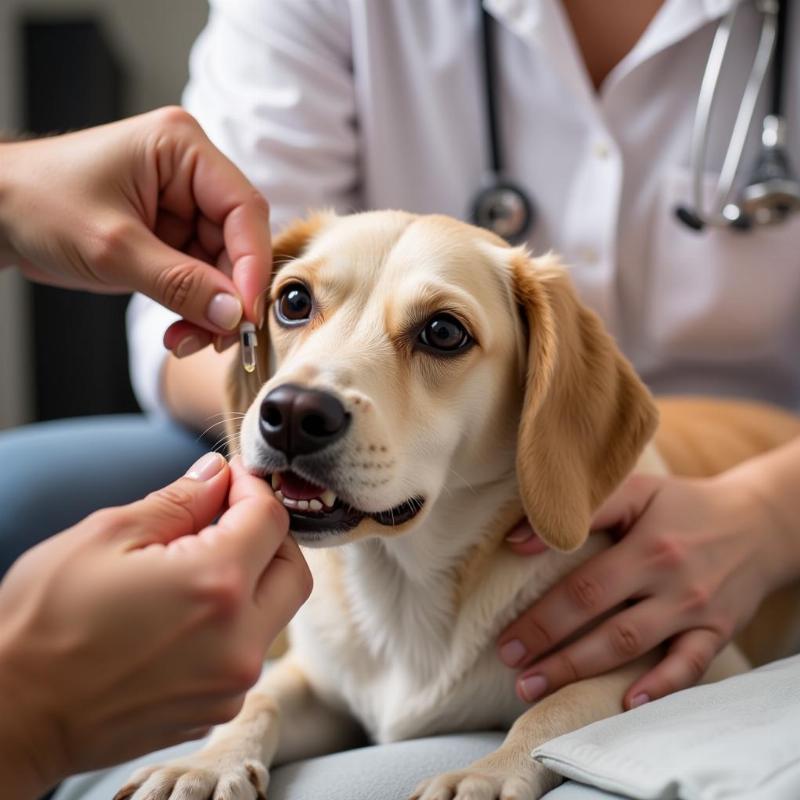A white speck in your dog’s eye can be alarming. Is it something serious? Does it require immediate veterinary attention? Understanding the potential causes of a white speck in your dog’s eye, from minor irritations to more significant conditions, is crucial for responsible pet ownership. This article will guide you through the possible reasons behind this symptom, available treatment options, and when it’s time to seek professional help from a veterinarian.
Common Causes of a White Speck in Your Dog’s Eye
Several factors can contribute to the appearance of a white speck in a dog’s eye. Some are relatively harmless, while others require prompt veterinary care. Here are a few possibilities:
- Corneal Ulcers: A corneal ulcer is a scratch or abrasion on the surface of the eye. It can appear as a white or cloudy spot. Ulcers can be caused by trauma, infections, or dry eye.
- Corneal Scarring: Previous eye injuries or infections can leave behind scar tissue, which might manifest as a white speck.
- Nuclear Sclerosis: This is a normal age-related change in the lens of the eye. While it can cause a cloudy or bluish-white appearance, it doesn’t typically affect vision significantly. It’s crucial to differentiate this from cataracts, which also cause cloudiness but impact vision.
- Cataracts: Cataracts are opaque areas that develop within the eye’s lens, hindering light from reaching the retina. They can appear as white spots or cloudiness and can significantly impair vision.
- Foreign Bodies: Sometimes, a small piece of debris, like dust, dirt, or a grass seed, can get lodged in the eye, appearing as a white speck.
When to See a Veterinarian
While some causes of white specks are benign, it’s always best to err on the side of caution. If you notice any changes in your dog’s eye, a visit to your veterinarian is recommended. Seek immediate veterinary attention if you observe any of the following:
- Excessive Squinting or Blinking: This indicates discomfort or pain.
- Redness and Swelling: These are signs of inflammation or infection.
- Discharge from the Eye: Discharge, especially if it’s thick, yellow, or green, can suggest an infection.
- Pawing at the Eye: Your dog might try to rub the affected eye due to irritation.
- Changes in Vision: If your dog bumps into objects or seems disoriented, their vision might be impaired.
Treatment Options for a White Speck
Treatment for a white speck in a dog’s eye depends on the underlying cause. Your veterinarian will conduct a thorough examination to determine the appropriate course of action. Possible treatments may include:
- Eye Drops or Ointments: These can be used to treat infections, lubricate the eye, or reduce inflammation.
- Oral Medications: In some cases, oral antibiotics or anti-inflammatory drugs may be necessary.
- Surgery: For conditions like cataracts or severe corneal ulcers, surgery might be the best option.
Preventing Eye Problems in Dogs
While not all eye problems are preventable, certain measures can help protect your dog’s eyes:
- Regular Eye Exams: Routine veterinary checkups are essential for early detection of any eye issues.
- Eye Protection: If your dog is prone to eye injuries, consider using dog goggles or protective eyewear, especially in environments with potential hazards like flying debris.
- Proper Grooming: Keep the hair around your dog’s eyes trimmed to prevent irritation.
- A Healthy Diet: A balanced diet rich in essential nutrients supports overall health, including eye health.
Living with a Dog with Chronic Eye Conditions
If your dog has a chronic eye condition, your veterinarian will provide guidance on long-term management. This might involve regular medication, special eye drops, or dietary adjustments.
 Applying Eye Drops to a Dog
Applying Eye Drops to a Dog
Conclusion
A white speck in your dog’s eye shouldn’t be ignored. While it could be a minor issue, it’s essential to consult your veterinarian for a proper diagnosis and treatment plan. Early intervention can prevent complications and ensure your furry friend’s eye health.
FAQ
-
Q: Can I use human eye drops on my dog?
A: No, never use human eye drops on your dog without consulting your veterinarian. Human medications can be harmful to pets. -
Q: How can I tell if my dog’s vision is impaired?
A: Signs of vision impairment include bumping into objects, hesitancy to navigate stairs or unfamiliar environments, and changes in behavior. -
Q: Are certain dog breeds more prone to eye problems?
A: Yes, some breeds are genetically predisposed to certain eye conditions. Consult your veterinarian or a breed-specific resource for more information. -
Q: How often should I clean my dog’s eyes?
A: Clean your dog’s eyes as needed, using a veterinarian-approved eye cleaner. If there is excessive discharge, consult your veterinarian. -
Q: Can diet affect my dog’s eye health?
A: Yes, a balanced diet rich in antioxidants and omega-3 fatty acids can support eye health. -
Q: What is the difference between nuclear sclerosis and cataracts?
A: While both can cause cloudiness, nuclear sclerosis is a normal age-related change that doesn’t significantly affect vision, while cataracts do impair vision. -
Q: How much does it cost to treat eye problems in dogs?
A: The cost varies depending on the diagnosis and treatment required. Consult your veterinarian for an estimate.
Beautdogs.us is your trusted source for comprehensive dog care information, breed insights, and product recommendations. We cater to both new and seasoned dog owners, providing expert advice and practical tips. For personalized support and inquiries, contact our team at [email protected] or call us at +1 501-555-7529. Visit Beautdogs.us for more valuable resources and enhance your journey with your canine companion!